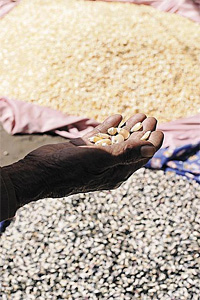 |
 |
 |
 Business News | February 2007 Business News | February 2007  
Mexican Farmers See Gold in Rising Prices
 Julie Watson - Associated Press Julie Watson - Associated Press


| | Corn is plentiful at this market in Ozumba, on the outskirts of Mexico City. Many Mexican farmers are shifting to or expanding corn production. (Pablo Spencer/Associated Press) |
Ciudad Serdan, Mexico — Rogelio Zacaula plucks an ear of corn from his field with the pride of a prospector unearthing the gold that legend says is buried in the slopes surrounding the nearby Orizaba volcano.

International corn prices driven by the burgeoning U.S. ethanol industry have soared to their highest in a decade, making farmers like Zacaula feel like they just won the jackpot.

"I have never seen prices like this," said Zacaula, 66, who has been growing corn since he was 10. "We suffered for so many years, years in which no one even wanted to buy our crop — until now."

Corn had languished around $2 a bushel for years before the ethanol boom caused prices to soar, reaching $4.04 a bushel this week. Corn prices should reach new highs over the next five years, according to Keith Collins, chief economist for the U.S. Department of Agriculture.

Already 111 U.S. ethanol biorefineries are in operation and 78 are under construction, according to the industry's Renewable Fuels Association.

Collins predicts U.S. farmers will need to plant 90 million acres of corn by 2010 — nearly 10 million more than now — to meet demand of the rapidly growing U.S. ethanol industry. And that means world markets will need to turn to corn-producing regions such as Latin America to fill the gap if U.S. exports drop.

Latin America's corn farmers are gearing up for such a possibility, snatching up land and blanketing their fields with corn after decades of struggling to compete against cheap, U.S.-subsidized imports. They hope to sell more domestically, and maybe even export more corn.

Boosted production

Brazil and Argentina, the Western Hemisphere's biggest corn exporters after the U.S., are expecting near-record harvests in 2007. Also in the top 10 is Mexico, corn's birthplace, and farmers here are rapidly boosting production.

Brazil, whose ethanol industry is fueled mostly by sugar cane, is also working on an agreement with the U.S. to share scientific research and development for biofuels.

Mexican farmers who now plant corn on 21 million acres are proposing expanding that by 4.3 million acres this year alone. They also want the government to fund the irrigation of another 1.9 million acres, said Carlos Salazar of the National Confederation of Mexican Corn Growers.

"Maybe the government will finally pay attention to us now that we're all dressed up pretty," Salazar said, referring to the healthy profits.

Mexican entrepreneurs now hope to transform the corn industry. While the biggest growers can sell directly to multinational firms, Salazar said his association is using the boon to find ways to guarantee local markets for medium and small size farms as well.

Private investors are pushing for ethanol plants to be built nationwide — new plants already are planned for at least three Mexican states, Salazar said — and leftist lawmakers want to require the state-owned oil monopoly Petroleos Mexicanos, or PEMEX, to oxygenate its gasoline with biofuels including corn, which could guarantee a local market for growers.

About 60 percent of Mexico's corn growers are subsistence farmers, producing just enough for their own consumption, and are not involved in the market. These farmers, who tend to grow on steep mountainsides that barely sustain their crops, are not likely to benefit from the boom in demand.

Poor Mexicans hurt

The hike in corn prices has hurt consumers, especially poor Mexicans whose diet depends on tortillas. It is also tough on livestock producers who buy feed corn.

For Mexico's more than 3.1 million commercial corn farmers, it could not have come at a better time.

Thanks to rains in key areas, Mexico's 2006 commercial corn production was the biggest in more than a decade, reaching 22 million tons (24 million U.S. tons) compared with a yearly average of 19.5 million (21 million U.S. tons), Salazar said.

In the Pacific coast state of Sinaloa, Mexico's agricultural powerhouse, industrial-scale growers recently doubled the amount of acreage of corn, switching 617,750 acres of soybean and other crops. Sinaloa producers, who now have planted corn on 1.1 million acres, are also buying more land, Salazar said.

Growers hope the ethanol phenomenon will cushion what they feared would be a devastating blow with the full opening of borders to U.S. exports of corn and beans in 2008 under the North American Free Trade Agreement, or NAFTA.

Since 1994, Mexico's rural sector has lost an estimated 1.6 million jobs, prompting many farmers to seek work in the U.S.

But Zacaula, a father of seven whose family cultivates 111 acres, says many of his fellow corn farmers are sticking around now while the money is good.

"They see that there are opportunities here," he said. | 
 | |
 |



